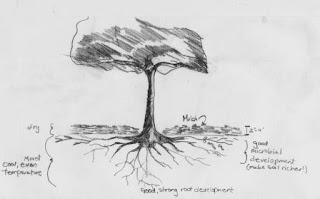Did you know that we carry bulk mulch, topsoil and compost at the Tree Farm? We can deliver it to you and your garden! We charge $50 per delivery trip. We don’t have the capacity to combine types of mulch/ soil in one trip.
Prices per cubic yard: $28, $35, $35
One cubic yard covers approximately:
100 sq ft= 3"
150 sq ft=2"
300 sq ft= 1"
Our soil and compost:
Pulverized Top Soil
Ton= $40.00
.5 ton= $30.00
Compost
Cu yd= $45.00
.5 Cu yd= $25.00
Instructions for mulching in your yard
It’s that time of year. Time to clean out the debris; the leaves, the dead, the limbs and twigs. It’s also time to replace mulch. Mulches are materials placed over the soil surface to maintain moisture and improve soil conditions. Mulching is one of the most beneficial things a home owner can do for the health of a tree. Mulch can reduce water loss from the soil, minimize weed competition, and improve soil structure. Properly applied, mulch gives your landscape a neat, tidy appearance too. Mulch must be applied properly; if it is too deep or if the wrong material is used, it can actually cause significant harm to trees and other landscape plants.
Types of Mulch- what to use, why and where
Mulches come in two major types: inorganic and organic. Inorganic mulches include various types of stone, lava rock, pulverized rubber, fabrics, and other materials. Inorganic mulches do not decompose and do not need to be replenished often. On the other hand, they do not improve soil structure, add organic materials, or provide nutrients. As plant specialists, horticulturalists recommend and prefer organic mulches in vegetable and garden beds. Inorganic/ rock mulches are great for drainage areas, near the house to minimize splashback and in beds that are not meant to grow plants.
Organic mulches include wood chips, pine needles, hardwood and softwood bark, cocoa hulls, leaves, compost mixes, and a variety of other products usually derived from plants. Organic mulches decompose in the landscape at different rates depending on the material and climate. Those that decompose faster must be replenished more often. Because the decomposition process improves soil quality and fertility, many arborists and other landscape professionals consider that characteristic a positive one, despite the added maintenance.
Organic mulches include wood chips, pine needles, hardwood and softwood bark, cocoa hulls, leaves, compost mixes, and a other plant matter. Organic mulches decompose in the landscape at different rates depending on the material and climate. Those that decompose faster must be replenished more often. Because the decomposition process improves soil quality and fertility, many arborists and other landscape professionals consider this a POSITIVE, despite the added maintenance.
We suggest that when you mulch trees you follow these rules. Yep- rules! Do not make a mulch volcano around your tree trunk. This is when the mulch is piled up 6 inches or so directly touching the trunk. Think of making a mulch donut instead! Keep the mulch low (about an inch) around the base of the tree- expose the trunk flare (where the base of the tree and roots meet). Then make a nice, wide donut about 2-4” deep out to the dripline of your tree or whatever is feasible. The dripline is width of your tree canopy. “Mulch wide- not deep” say the professionals!


Landscape Company Near me I would like to say that this blog really convinced me to do it! Thanks, very good post.
ReplyDelete